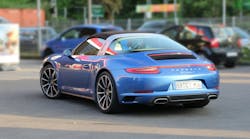For a company best known for the driving performance of its sports cars, Porsche doesn’t consider it a contradiction to consider the ongoing development of assisted-driving technologies as core to its strategy.
In fact, the automaker is doubling down on enhanced ADAS capabilities in combination with cloud-based services and seeking—all in the pursuit of creating a better experience with the customer behind the wheel.
“We want to ease our customers’ lives in traffic situations that don’t incorporate a fun factor in order to help them more fully enjoy driving our sports cars in the future,” is how Jurgen Bortolazzi, Dr. Ing. H.c.F. Porsche AG, described the company’s embrace of driver-assistance systems during his keynote at today’s electronica Automotive Conference.
Since introducing adaptive cruise control and park distance control in the mid-2000s, Porsche has pursued what it calls an Intelligent Performance Strategy. It includes the predictive Innodrive system, which uses a planning algorithm to enable efficient cruise control.
Porsche is showcasing its latest innovation—automated parking—in Hamburg. “We think that parking is one of the most boring activities for drivers,” explained Bortolazzi, describing how once a driver hands over control to automation, a car is able to find the designated parking spot and park itself. For the record, the automaker is finding that these innovations are being well-received by customers.
At the Heart of the System
The core of Porsche’s ADAS system architecture is a powerful central control unit that offers basic services and custom functions, including active land assist and image processing during parking. A 360-degree model based on data from over two dozen sensors and inputs—from LiDAR to ultrasonic sensors and front and surround video cameras—also provides massive performance improvements.
Bortolazzi said that Porsche engineers have done lots of driving on roads and sampling of data, all of which is forming the basis for a first generation of data-driven developments and technologies such as predictive speed optimization based on road topology.
But with many more sensors contributing to a significant increase in data and the need to provide the necessary analytics, Bortolazzi sees challenges ahead as more ADAS capabilities are based on predictive algorithms. “Managing the data will be a challenge,” he said. “We are going to need a quantum leap in board processing performance to handle these large datasets.”
What roles machine learning and AI will play must be sorted out as well. “From our point of view—at least in the foreseeable future—it will play an important role, but as a contributor to the system, it will not be the key part of the system itself," said Bortolazzi.

